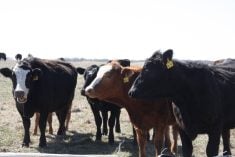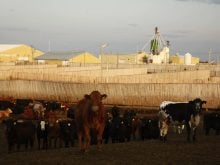Fed prices stronger
Weighted average steer prices were $145.32 per hundredweight in light trade, down 25 cents, and heifers were $146.79, up $2.
There was some U.S. buyer interest, but significant trade did not develop.
The cash to futures basis narrowed $2 to -$14.52. Total sale volume fell 21 percent to 7,727 head.
Weekly western Canadian fed slaughter to March 29 fell 10 percent to 35,288 head.
Weekly Canadian fed exports to March 22 rose 19 percent to 11,891 head. The week’s offering included pen cleanups of varying cattle types and quality.
Read Also

Flax sector sees omega-3 opportunity
SASKATOON — A global shortage of omega-3 oils could be an opportunity for the flax sector, says an industry official….
Recently, marketed carcass weights were lighter than anticipated, and slaughter summaries indicate cattle should now be staying on feed longer.
Prices will likely edge lower on a seasonal trend.
Cows post records
Record highs were set for all classes of non-fed cattle as butcher cows and bulls traded $1-$3 stronger on tight supply.
Western Canadian slaughter volumes have fallen to 5,800 per week from 7,200 over the past month.
Seasonal highs tend to be set in mid-April.
D1, D2 cows traded in a range of $97-$115 to average $105.42.
D3 cows ranged $80-$102 to average $91.75.
Rail grade cows were $200-$205.
Feeders stronger
The market saw strong local, eastern and U.S. demand, which supported prices.
The April Chicago feeder contract traded within 200 points of the contract high.
Bullishness in the feeder complex is mostly supply driven.
Feeder procurement strategies now favour lighter cattle because of cheaper feed grains, compared to last year when the market favoured heavier cattle.
Barley prices are down 35 percent from last year, improving the economics of cattle feeding.
Feedlots are bidding aggressively against grass buyers to procure mid-weight stockers.
Alberta average steer prices are trading at a slight premium over Sask-atchewan and Manitoba, except for 400-600 pound heifers.
The eastern Prairies are closer to the Nebraska market, and these light stocker heifers could be going south.
Weekly feeder exports to March 22 were 17,107 head, the most since September 2008.
There appears to be little risk for sellers in forward pricing cattle into May. May is fetching a premium over current cash prices.
Prices next week might be a little lower because of the strength in the loonie and a decline in Chicago feeders late in the week.
Bred cows were $1,350-$1,925 last week, while bred heifers were $1,275-$1,900 and cow-calf pairs were $1,700-$2,750.
Beef prices down
U.S. Choice fell $7.30 US last week to $231.95 per cwt., and Select fell $9.80 to $221.41.
Canadian data has fallen behind.
Canadian cut-out values for the week ending March 21 were mixed with AAA down $1.42 Cdn per cwt. at $237.19 and AA was up 82 cents at $240.71.
Warmer weather in Western Canada is expected to support middle meat prices, which could help narrow the AAA-Choice spread when combined with lower U.S. prices.
Montreal wholesale prices for delivery this week were steady at $262-$264 per cwt.
This cattle market information is selected from the weekly report from Canfax, a division of the Canadian Cattlemen’s Association. More market information, analysis and statistics are available by becoming a Canfax subscriber by calling 403-275-5110 or at www.canfax.ca.














